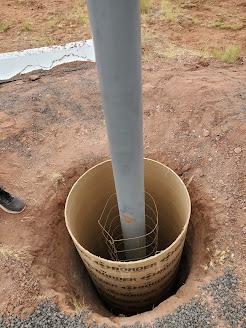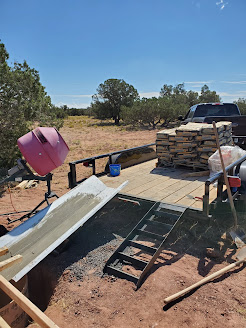It has been a strange fall semester, but it is coming to a close and the Thanksgiving break is very welcome. ASU has adapted to COVID-19 by offering in-person classes over Zoom as well as in the classroom. Husband is taking all of his classes online already and I teach most of my classes online, though I do have one in-person class which is being "Zoomed" to students who don't want to attend in-person (most of them).
Brother is in 6th grade and Sister is in 1st grade. Our homeschooling curriculum is a hybrid of IXL, Moving Beyond the Page, Duolingo, literature, workbooks, real-world events, and homestead happenings. Both kids are doing very well, but they would benefit from having some friends to play with. Currently their social life consists of hanging with their cousins via phone or video game consoles. They enjoy their virtual play time, but it would be better if they could run around outside with other kids their age. Last week we stopped at an empty park to let the kids run around - it had been some time since they were able to play on a playground. They really had fun, but I was again reminded how nice it would be if they could connect with others their ages.
Even in the past when we homeschooled we still had play dates and met friends at parks - this year has been an exception. I suppose many families are in this situation. I am happy to hear about the vaccines that seem to have promise, because it would be great to see our friends again.
Certainly we parents are not the best playmates for our kids - I am generally pretty serious when they are super silly. I am task focused when they are aimless. I have a to do list and they just wanna be free to be on screens when I want them to do chores. Of course I love going to the National Parks where we can focus on learning something together or going for a hike together. I love teaching them, reading with them, and talking about things. They are bright and curious, they have great insights. They are helpful and sweet. For the past 3.5 years we have spent most of our time together since Husband and I have mostly worked from home and the kids have mostly been homeschooled. We are close and I have valued every minute of our increased time together over these years. With that said, I know it would especially benefit Brother to have a bit of an life away from our life - he will be 11 soon and he would benefit from having other kids to talk 11-year old things with.
The kids are helpful around the house, Brother does dishes and Sister puts them away (we haven't had a dishwasher for 3.5 years). They also fold and put away laundry. I was just thinking that Brother could take on a couple new chores as he turns 11....
Oh and speaking of laundry - I bought a portable RV washing machine! It fills from the bathroom sink and empties into the shower - not manually - you have to turn on/off the water and the pump to fill/drain it. When the wash and rinse are done you move the clothes in batches to the spinner and then I hang everything up on my drying rack or out on the line. This week has been the first in 3.5 years I have not gone to the laundry mat! The washer cost approx $140. I figured I spend at least $10/week on laundry so if I avoid the laundry mat for 14 weeks this purchase will have been worth it. I will spend more time on laundry using this machine - the main benefit of the laundry mat is being able to wash and dry everything at the same time instead of in batches. Of course in the time of COVID-19 I value not going to the laundry mat and think this is a good choice. Also, this can travel with us in the RV. It is very low powered as well and works well on our solar system (260W wash/140W spin). Here is it 'set up' in our bathroom with the hose coming from the sink at the top and the drain hose on the bottom left run into the shower. Wow, modern conveniences on the homestead!
Sister has been reading Roald Dahl books this semester. She read the BFG, Fantastic Mr. Fox, and is almost done with George's Marvelous Medicine. She is really improving in her reading skills. Husband is the lead on reading with Sister and I am the lead on language arts with Brother. Brother and I just finished Tuck Everlasting - that was a great book. Moving Beyond the Page is great for the older kids because the curriculum includes a lot of writing - which is something I feel should be a major focus leading up to college. Sister has two first grade workbooks that supplement her IXL lessons. Her handwriting is better than Brother's! They are both great students and I am so proud of them. We are a family focused on scholastic endeavors all around!


































































